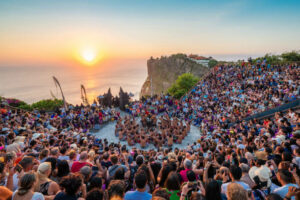Visiting Uluwatu Temple, one of Bali’s most iconic sites, offers an unforgettable blend of culture, dramatic scenery, and captivating performance. Imagine standing atop soaring cliffs, the vast Indian Ocean stretching before you, while waves crash seventy meters below. Picture a sacred ancient temple, home to some famously mischievous monkeys, all bathed in the golden glow of sunset. Then, add the rhythmic chanting of a hundred men performing a unique fire dance… This is the magic of Pura Luhur Uluwatu, an experience that truly captures the spirit of Bali.
Uluwatu Temple provides more than just stunning scenery; it stands as one of the island’s most important spiritual pillars. And the good news for guests in Nusa Dua? Its location on the southwestern tip of the Bukit Peninsula makes it a relatively easy and incredibly rewarding trip.
Whether the cultural significance, the jaw-dropping views, or the famed Kecak dance performance at sunset draws you in, a visit to Uluwatu often becomes a highlight of any Bali itinerary. As your friendly guides here at Merusaka, we’d love to share insights and practical tips. We want to help you plan a smooth, memorable, and respectful visit. So, let’s explore what makes Uluwatu so special and how to make the most of your trip from Nusa Dua.
The Majesty and Meaning of Pura Luhur Uluwatu
Before diving into practicalities, let’s appreciate why Uluwatu holds such deep significance for the Balinese people.
Spiritual Significance as a Pillar Temple The Balinese revere Pura Luhur Uluwatu as one of the Sad Kahyangan Jagat. These are the six key spiritual temples believed to act as pillars for Bali, protecting the island from harmful forces. Balinese Hindus dedicate the temple to Sang Hyang Widhi Wasa (the Supreme God) in his manifestation as Dewa Rudra. This divine force, associated with the elements, acts as a protector, particularly guarding Bali from unruly forces emanating from the sea. Consequently, visiting Uluwatu offers a glimpse into the profound spiritual connection the Balinese maintain with their environment and the divine. This reflects the core island philosophy of Tri Hita Karana .
Historical Roots The temple’s origins trace back through ancient history. Historical texts link its establishment or expansion to revered holy men like Empu Kuturan in the 11th century and Dang Hyang Nirartha in the 16th century, both highly influential figures in Balinese Hinduism.
Dramatic Cliffside Setting The name “Uluwatu” itself offers clues: “Ulu” means ‘land’s end’ and “Watu” means ‘rock’. True to its name, the temple complex sits dramatically perched right on the edge of towering limestone cliffs that plunge into the ocean below. This location provides more than just spectacular views; it holds symbolic significance, representing a powerful connection point between the land (Bhuana Agung) and the sea.
Architectural Beauty As you explore, you’ll notice classic Balinese architectural features. Look for the split gateway entrances (Candi Bentar) and intricately carved stone details. Visitors can explore the outer courtyards and the cliffside pathways. However, please remember that entry into the innermost sanctuary (Jeroan) is typically reserved for those actively praying or participating in ceremonies, a common practice in most Balinese temples.
Unforgettable Panoramic Vistas The walkways along the cliff edge provide truly breathtaking, uninterrupted views over the Indian Ocean. It’s undoubtedly a photographer’s dream location. Furthermore, the scenery becomes especially magical as the sun begins its descent, painting the sky in fiery, unforgettable colors.
Getting There: Your Journey from Nusa Dua
Visiting Uluwatu while staying in Nusa Dua offers the advantage of relatively short travel time. You’re already located on the Bukit Peninsula, making the journey much closer compared to traveling from areas like Ubud or Canggu.
Estimated Distance and Time You should expect the drive from Nusa Dua to Uluwatu Temple to take approximately 30 to 45 minutes. However, the actual time depends heavily on traffic conditions. Be aware that traffic heading towards Uluwatu can become significantly heavier in the late afternoon. This is because many people travel there specifically for the sunset and the Kecak dance. Therefore, we recommend allowing a little extra travel time if you are aiming for sunset.
Choosing Your Transport Here are a few options to consider for your journey:
- Taxi or Ride-Hailing Apps (Gojek/Grab): These services are readily available in Nusa Dua for the trip to Uluwatu. You can easily book a car via the relevant apps. However, getting a ride back after the Kecak dance finishes can sometimes be more challenging. High demand right after the show and the temple’s slightly remote location can lead to longer waits or potentially higher fares. It’s wise to consider pre-booking your return trip via the app (if possible), negotiating a waiting fee with your arrival driver, or being prepared for a possible delay.
- Private Driver / Car Charter: This option often provides the most convenience and a stress-free experience. It’s especially useful if you plan to visit other spots on the Bukit Peninsula (like Padang Padang or Bingin beaches) or simply want flexibility. You hire a car and driver for a set number of hours (e.g., 4-6 hours or longer). The driver will wait for you at the temple complex and take you directly back to your hotel afterward. Our concierge team at Merusaka would be delighted to assist you in arranging a reliable and comfortable private car service.
- Scooter/Motorbike: Renting a scooter offers maximum flexibility for experienced riders comfortable with Indonesian traffic conditions. However, please ensure you possess the appropriate international driving permit and always wear a helmet for safety. Be mindful that roads can be busy. Additionally, riding back after dark requires extra caution due to lighting and traffic.
Navigating Your Visit: Practical Tips for a Smooth Experience
Once you arrive at Uluwatu, these helpful tips can make your exploration more comfortable and respectful:
Visiting Hours & Fees
- Opening Hours: The temple grounds generally welcome visitors daily from around 7:00 AM to 7:00 PM. Keep in mind that specific prayer times or larger ceremonies might occasionally affect access to certain areas within the complex.
- Ticket Information: You will need to pay an entrance fee at the ticket counter upon arrival. As of early 2025, the fee was approximately IDR 50,000 per adult. Please note this fee is subject to change, so it’s best to check the current cost when you arrive. This fee helps maintain the extensive temple complex.
Respectful Attire: Dress Code Essentials
- Modesty is Mandatory: Remember, Uluwatu is a deeply respected sacred site. Therefore, visitors must dress modestly. This means both men and women need to ensure their shoulders and knees remain covered while within the temple grounds.
- Sarong and Sash Provided: Don’t worry if your attire for the day isn’t quite right! Temple rules require visitors to wear a sarong and sash (selendang) for entry. These items are usually included with your entrance ticket or are readily available to borrow right at the gate. Even if you’re wearing long trousers or a long skirt, attendants will likely ask you to wear the temple sarong and sash as a sign of respect.
Meet the Locals: Uluwatu’s Macaques Uluwatu is famous (or perhaps infamous!) for its resident population of long-tailed macaques. While they certainly add to the atmosphere, it’s important to remember they are wild animals. They are known for their cleverness and tendency to snatch belongings!
- Keeping Your Belongings Safe: Before you even walk through the entrance gates, take precautions. Securely put away sunglasses (even off your head!), hats, caps, water bottles, and any snacks. Also, secure any dangling jewelry or accessories like keychains hanging off bags. Keep your phone held securely, especially when taking photos. Hold onto your bag firmly and ensure all zippers remain closed.
- Interaction Advice: Please do not feed the monkeys. Feeding encourages their boldness towards humans and can disrupt their natural diet and social behaviours. Additionally, try not to make direct eye contact for long periods. Avoid baring your teeth, even in a wide smile, as monkeys might interpret this as a sign of aggression.
- How to React: If a monkey approaches you or even manages to grab something, the best advice is to stay calm. Do not panic or fight it aggressively, as this could escalate the situation. Temple staff are often nearby and experienced in handling these situations. They can sometimes assist in coaxing the monkey to drop the item, frequently in exchange for some fruit (it can be helpful to have a small amount of cash ready to purchase fruit from staff for this purpose if needed).
- View the monkeys as part of Uluwatu’s unique character, but always exercise caution and common sense to prevent unwanted encounters.
Exploring the Temple Grounds
- Walk the Pathways: Take your time strolling along the paved pathways that wind along the clifftops. These routes offer multiple viewpoints with different perspectives of the temple architecture and the stunning ocean vistas.
- Be Mindful of Crowds: Be aware that the temple, especially the main areas and the Kecak amphitheater, can get quite crowded. This is particularly true in the hour leading up to sunset. Practice patience and be mindful of other visitors sharing the space.
- Safety Near Edges: Always stay safely behind any barriers or railings near the cliff edges. The views are incredible, but safety must always come first.
Best Time for Your Visit
- Mornings for Quiet: Consider visiting earlier in the day for fewer crowds and beautiful morning light, which offers different photographic opportunities.
- Late Afternoon for Sunset & Kecak: However, the most popular time is undoubtedly the late afternoon. Arriving around 4:00 PM to 4:30 PM generally allows enough time to explore the temple grounds leisurely, purchase your Kecak dance ticket without rushing, find a good spot for viewing the sunset, and then settle in for the performance.
The Sunset Spectacle: Experiencing the Kecak Dance
The Kecak Fire Dance performed at Uluwatu as the sun dips below the horizon ranks as one of Bali’s most iconic cultural performances. It truly offers a unique and captivating experience.

Traditional Kecak Fire Dance performance at Uluwatu Temple at sunset in Bali, Indonesia.
Understanding the Kecak Performance
- The Chanting Chorus: Unlike most Balinese dances accompanied by a traditional Gamelan orchestra, the Kecak stands out due to its powerful vocal chanting. A large troupe of bare-chested men sits in tight concentric circles. They rhythmically chant “cak-cak-cak” (pronounced roughly ‘chak-chak-chak’), creating an intense, hypnotic, percussive soundtrack throughout the performance.
- The Story of the Ramayana: This chanting chorus often represents the Vanara, the army of monkeys assisting Prince Rama in the famous Hindu epic, the Ramayana. The performance typically depicts a key episode from this story. Usually, it’s the dramatic tale of Prince Rama rescuing his wife, Princess Sita, from the clutches of the demon king Rahwana, with help from the loyal monkey god Hanuman.
- The Fire Dance Element: Dancers in elaborate traditional costumes portray the main characters. The performance incorporates dramatic storytelling, expressive movement, and often includes thrilling fire dance elements, particularly involving the brave Hanuman character.
Venue, Timing, and Tickets
- The Setting: The Kecak dance takes place in a purpose-built, open-air stone amphitheater. Its location is spectacular, perched right on the cliff edge adjacent to the main temple area, offering phenomenal sunset views as a natural backdrop.
- Show Time: The performance typically starts around 6:00 PM each evening. It lasts for approximately one hour, and organizers time it perfectly to coincide with the sunset.
- Securing Your Seats: Important note: The ticket for the Kecak Dance is separate from your temple entrance fee. You’ll usually find a dedicated ticket counter for the dance located within the temple complex, often near the amphitheater entrance. We highly recommend purchasing your Kecak tickets as soon as you arrive at the temple in the late afternoon. This is especially crucial during peak tourist season. Seating is generally unassigned (first-come, first-served basis), and popular shows can sell out or become very crowded quickly. As of early 2025, the ticket price was around IDR 150,000 per person (this price is subject to change, so please confirm when purchasing).
The Experience Itself Find your seat in the stone amphitheater – arriving a bit earlier gives you a better choice of viewpoint! Then, prepare to be mesmerized. The combination of the rhythmic, hypnotic chanting filling the air, the vivid storytelling unfolding through dance and costume, the dramatic flickering fire elements, and the breathtaking panorama of the sun setting over the vast Indian Ocean creates an atmosphere that is both intensely dramatic and deeply moving. Consequently, it’s a powerful cultural immersion you won’t soon forget.
After the Show Logistics Finally, be prepared for crowds when exiting the amphitheater after the performance. It can take a little while for everyone to file out. This is also the peak time when finding available transport back can be most challenging due to the large number of people leaving simultaneously. As mentioned earlier, having your return transport pre-arranged will undoubtedly make your departure much smoother and more relaxed.
Your Unforgettable Uluwatu Excursion
A visit to Pura Luhur Uluwatu truly offers an incredible blend of Bali’s spiritual heart, stunning natural beauty, and vibrant performing arts. Furthermore, its relatively easy access from Nusa Dua makes it an almost essential experience during your stay on the Bukit Peninsula.
By arriving prepared – dressing respectfully, being mindful of the monkeys, allowing ample time, and perhaps arranging your transport beforehand – you can fully immerse yourself in the magic of this sacred cliffside temple and its unforgettable sunset Kecak performance.
We truly hope this guide helps you plan a wonderful visit. Should you need any assistance with arranging transport or have further questions about visiting Uluwatu or other Bali destinations, please don’t hesitate to speak with our knowledgeable team at the Merusaka concierge desk . We’re always here to help make your Bali adventures seamless and memorable.
Enjoy the breathtaking views and cultural richness of Uluwatu!



